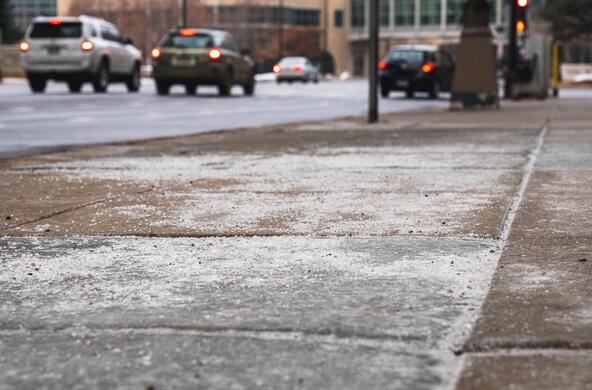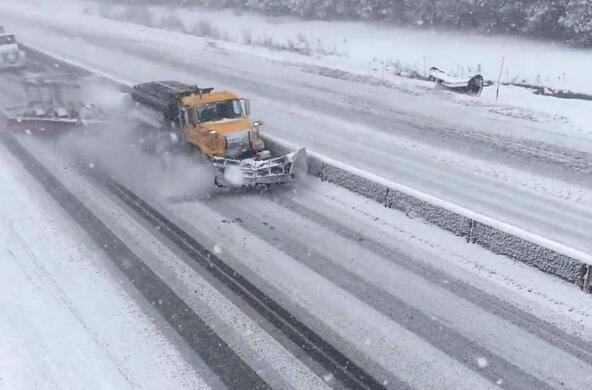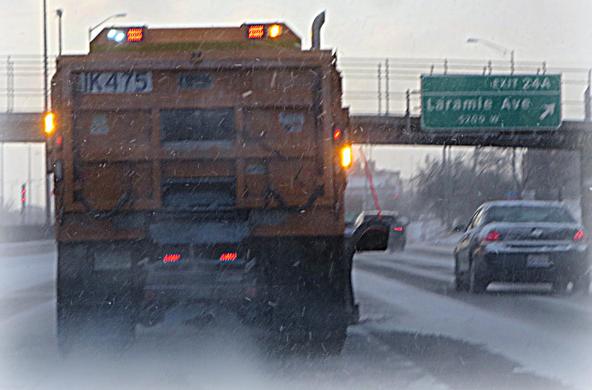Scientists in Kansas and Iowa are working on a greener path forward. In the meantime, experts offer tips for public agencies and homeowners to use salt smarter.
Rock salt saves lives by helping tires grip icy roads. It avoids broken bones when homeowners use it on slick sidewalks, driveways and parking lots.
And in Kansas, one of the country’s top salt producers, rock salt generates paychecks.
But it also costs Americans billions in corroding cars and bridges. It adds so much sodium to drinking water in some places that it can affect people’s health. And in some places, toxic salt levels kill or harm plants, animals and crops.
Experts say we can take immediate steps to curb this toll without sacrificing road safety. (Read tips for homeowners here and winter maintenance crews here.)
The Kansas Department of Transportation has already taken some of those measures, including spraying brine before winter storms, a practice that can fight slippery roads with less salt.
And at Wichita State University and Iowa State University, scientists are pursuing research that could change how we clear our pavement in the cold months.
Backed by a $1.4 million grant from the National Science Foundation, they’re working on capturing some of the salt that pollutes our water — such as salt stemming from the nation’s burgeoning water softener industry — and converting it into an environmentally friendly deicing product.
“We save tremendous lives on the road” by deicing it, Wichita State mechanical engineering professor Shuang Gu said. “I appreciate this practice. (But over the decades,) we have exponentially applied road salt.”
The rise of road salt
Americans may like salty food, but we use far more sodium chloride on our roads than on our dinner plates. Its use increased at a steep clip last century when we built interstate highways for more vehicles to travel at faster speeds.
Today, the U.S. dumps about 160 pounds of salt per person on its roads, sidewalks, driveways and parking lots.
Groundwater and lakes in some places are ailing — especially in the country’s north. Since it takes time for salt to wind its way from our roads and ditches to streams, lakes, wells and aquifers, scientists at the Cary Institute of Ecosystem Studies say the salt levels in our fresh water could keep rising for years or decades even if we quit using road salt immediately.
Prospects for reversing this damage look dim, scientists say, fueling a mad dash to reduce our reliance on this deicer.
Yet salt is cheap. So although alternative substances already exist on the market, they come with higher price tags, logistical challenges or other limitations.
This means that salt — in particular, crushed rock salt — remains the No. 1 method for deicing pavement, the American Geosciences Institute says.
What’s the impact?
For centuries, humans have told tales of conquerors sowing the fields of their enemies with salt. Those may be fables, but the fact that we’re salting our own watersheds today is not.
The Geological Survey monitored the effects over half a century on streams and other sites in eight states. At nearly one-third of their sites, chloride pollution reached toxic levels for, on average, a third of the year.
In New York, scientists sampled private drinking water wells and found that most topped the EPA’s health standards for salt in water. High salt levels endanger trout in New York by hampering the natural circulation of lake water so that less oxygen reaches deeper depths.
The Environmental Protection Agency says road salt also necessitates about $5 billion in repairs to bridges and other infrastructure each year. And it’s a suspected cause of the lead pipe corrosion that poisoned the water in Flint, Michigan.
Road salt also poses a concern for people with high blood pressure whose local drinking water has higher sodium levels, the EPA says. It kills roadside plants, harms crops, increases erosion and hurts frogs and insects, both of which play important roles in the food web.
Some northern states are taking action. A decade ago, New Hampshire launched a salt-reduction program because chloride pollution had become a problem in dozens of its water bodies. The state cut road salt application by one-fifth, the EPA says.
What’s happening in Kansas?
Kansas sits on a sea of salt. Literally.
Hundreds of millions of years ago a shallow sea dried up. Today, mines in central Kansas turn those vast salt deposits into jobs and income.
Kansas ranks among the seven states that produce 95% of the nation’s salt, the U.S. Geological Survey says. Nationwide, salt is a multibillion-dollar industry. Kansas produces more than $200 million worth of the mineral per year.
The Kansas Department of Transportation spread 83,000 tons of rock salt to keep drivers safe on state highways during the winter of 2021-2022.
“Our crews feel very responsible when they’re out on the road,” said Clay Adams, director of field operations, “to make sure that the roads are as safe as possible.”
But the agency has also made changes to address salt pollution.
It moved its stockpiles of salt to facilities where it can prevent runoff and began cleaning its trucks in special wash bays, to capture the highly salty wastewater for treatment.
“We used to wash them outside, just out in the parking lot outside our shops,” Adams said.
The agency also takes pains to calibrate its trucks so they spread just the right amount of salt — another important control, the Cary Institute says.
And the agency increasingly leans on brine, one of the best tricks of the trade to prepare for storms — and one that can reduce the need for rock salt after snowfall.
State workers started experimenting with brine in central Kansas in the 1990s, mixing it in a stock tank in one of the garages.
Roger Alexander was a KDOT engineer in Salina back then with a penchant for trying new things.
So the agency had set him to work on a federal project designed to scrutinize different ways of clearing roads around the US and the world and to pin down which worked best in which conditions. Brine can work wonders.
“It would stick to the road better than anything else,” he said. “If it started snowing, instead of having the snow get packed on and freeze, it would melt and basically run off the road.”
The Cary Institute says proper brine treatment may reduce overall salt use by as much as 75%.
Pre-treating with rock salt, by contrast, doesn’t work. As cars pass, it just bounces and scatters.
“Whatever you put down,” he said, “you just wasted.”
Today, Kansas uses brine treatment across the state. It draws on other tricks, too, like coating rock salt with brine to help it stay put, or spiking its road treatments with viscous byproducts from beet and corn processing. Those compounds can turn snow to a kind of oatmeal consistency that’s easier to plow.
Alexander says engineers and road crews have a long list of factors to consider anytime they weigh their options. Is the day super windy? Will a storm start with rain and end with snow? What kind of plows and how many do you have available? Sometimes rock salt is their best option.
What are Midwest scientists doing?
Scientists in Kansas and Iowa envision a new way to keep us safe in winter by recycling salt found in urban wastewater.
They’re working on producing sodium formate, a noncorrosive deicer that airports and military facilities use.
Studies suggest bacteria break down sodium formate, and that the compound doesn’t harm the environment the way salt does. (Still, part of the four-year project includes further scrutinizing its effects.)
The substance has two notable disadvantages that the teams at Wichita State and Iowa State want to overcome. One, it’s too expensive for use on America’s vast system of roads and highways. Two, it’s made with natural gas, which raises other environmental concerns.
Lead researchers Gu and Wenzhen Li (a chemical and biological engineering professor at Iowa State) have homed in on a way to produce sodium formate without fossil fuels.
The process involves concentrating salt from wastewater — in particular, the highly concentrated salt released by increasingly common water softener systems — and using it in a chemical reaction that combines carbon dioxide and salt into sodium formate without needing natural gas.
That would produce chlorine as a byproduct, which could go toward sanitary purposes and swimming pools.
The EPA says scientists are exploring other approaches to the nation’s salt problem, too, such as using porous pavement that lets water seep through and reduces ice formation in the first place.
Gu calls himself a realist. Solutions will take time. His team’s work will take years. Yet with each winter that passes, more salt accumulates in U.S. waterways. The best tool available today is public buy-in.
“There are many challenges ahead of us,” he said. “We should somehow raise public awareness … Let people know that there is a problem and we need to use road salt more responsibly.”







